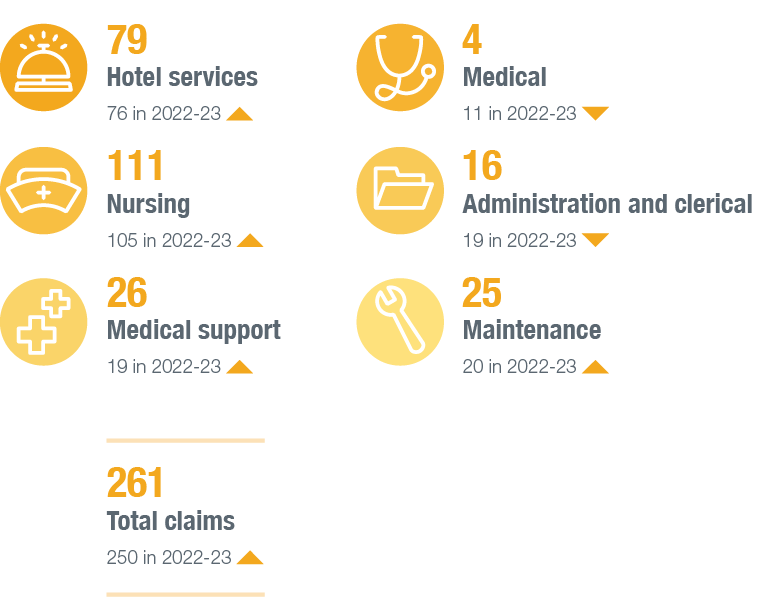Our commitment to safety and wellbeing
The health, safety and wellbeing of our workers, patients, consumers, visitors and anyone affected by the work of our health service is a priority. EMHS takes a prevention-focused risk-based approach to identifying, assessing, managing, monitoring and evaluating work health, safety and wellbeing matters, performance and outcomes.
The EMHS Board and Area Executive Group (AEG) maintain oversight of health, safety and wellbeing matters to deliver effective leadership, support and direction, and ensure resources are provided to meet work health and safety (WHS) and wellbeing operational requirements and strategic improvement.
EMHS’ commitment to WHS reflects our values and is demonstrated by facilitating a culture that integrates safety into all activities.
We acknowledge our shared duties under the Work Health and Safety Act 2020 (WA) and Work Health and Safety Regulations 2022, and the Workers’ Compensation and Injury Management Act 1981 (WA) and Workers’ Compensation and Injury Management Regulations 1982.
Work health and safety performance indicators
Number of fatalities
| Year | Target | Actual | |
|---|---|---|---|
| Years 2023-24 | Target 0 | Actual 0 |
|
| Years 2022-23 | Target | Actual 0 |
|
| Years 2021-22 | Target | Actual 0 |
|
| Years 2020-21 | Target | Actual 0 |
|
Lost Time Injury and Disease (LTI/D) incident rate (per 100)
| Year | Target | Actual | |
|---|---|---|---|
| Years 2023-24 | Target 2.76 | Actual 3.00 |
|
| Years 2022-23 | Target | Actual 2.37 |
|
| Years 2021-22 | Target | Actual 3.07 |
|
| Years 2020-21 | Target | Actual 2.90 |
|
LTI/D severity rate (percentage LTI/D)
| Year | Target | Actual | |
|---|---|---|---|
| Years 2023-24 | Target 38.44 | Actual 44.94% |
|
| Years 2022-23 | Target | Actual 42.01% |
|
| Years 2021-22 | Target | Actual 40.61% |
|
| Years 2020-21 | Target | Actual 46.41% |
|
Percentage of injured workers returned to work within 13 weeks
| Year | Target | Actual | |
|---|---|---|---|
| Years 2023-24 | Target 70.0% | Actual 48.2% |
|
| Years 2022-23 | Target | Actual 46.3% |
|
| Years 2021-22 | Target | Actual 43.3% |
|
| Years 2020-21 | Target | Actual 46.0% |
|
Percentage of injured workers returned to work within 26 weeks
| Year | Target | Actual | |
|---|---|---|---|
| Years 2023-24 | Target 80.0% | Actual 61.8% |
|
| Years 2022-23 | Target | Actual 66.5% |
|
| Years 2021-22 | Target | Actual 60.6% |
|
| Years 2020-21 | Target | Actual 63.0% |
|
Percentage of managers and supervisors trained in occupational safety, health and injury management responsibilities
| Year | Target | Actual | |
|---|---|---|---|
| Years 2023-24 | Target 80.0% | Actual 73.5% |
|
| Years 2022-23 | Target | Actual 63.1% |
|
| Years 2021-22 | Target | Actual 72.3% |
|
| Years 2020-21 | Target | Actual 73.0% |
|
Consultation
EMHS values the contributions of our workforce, with mechanisms for consultation including:
- supporting 279 elected Health and Safety Representatives (HSRs) to ensure all workers have access to an HSR
- providing HSR training, education and networking opportunities, including a forum held in May 2024
- 10 WHS committees that meet the requirements of the WHS Act, to facilitate consultation and cooperation between leadership and workers in continuous improvement of all aspects of WHS
- hazard and incident reporting, quarterly workplace inspections and annual aggression risk assessments.
Governance and compliance
EMHS WHS governance and oversight occurs through:
- officer assurance activities, such as workplace rounding and meetings
- reporting and analysis of performance data and feedback to EMHS Board, AEG and WHS committees
- establishment of the Peak EMHS Wellbeing, Work Health and Safety Committee (Peak Committee), the overarching committee for EMHS to develop and drive strategic direction for health, safety and wellbeing matters. The Peak Committee is accountable to the EMHS AEG.
An EMHS safety management systems audit was completed in the financial year. Actions to meet the recommendations of the audit will be monitored through the service based WHS committees and the Peak Committee.
EMHS values its relationship and collaboration with its public-private healthcare partners, other Health Service Providers (HSPs) and the Department of Health System Manager on health-wide WHS matters.
Wellbeing
Through the EMHS Wellbeing Framework and Strategy, EMHS has adopted a contemporary approach to workplace wellbeing with a focus on prevention and identification of psychosocial hazards – viewing leadership, work design and consultation as key contributors to psychosocial safety and wellbeing.
The wellbeing programs offered include education programs for all staff, such as in-service opportunities provided by the WHS team and the Nexus Human Performance Training Program, and the promotion of wellness and wellbeing initiatives such as financial management education and personal health and fitness programs.
To support the wellbeing of our staff, EMHS offers a range of services which include:
- trauma-informed critical incident response
- care and support for individuals and work groups provided by the Centre for Wellbeing and Sustainable Practice, the WHS Team and work unit managers and supervisors
- EMHS Employee Assistance and Manager Assist Programs
- providing training for managers in work health and safety.

WorkSafe improvement notices
EMHS was not issued with any WorkSafe notices during 2023-24 and as at the end of the financial year had no open notices.
Any work safe notices received by EMHS are forwarded to the executive team and actions are addressed by the relevant directorate. The completion of notices is governed by the WHS committees and open notices are monitored through the Peak Committee to the AEG.
Injury management
EMHS has a dedicated Injury Management Team (IMT) that functions in accordance with the Workers’ Compensation and Injury Management Act 1981 (WA).
The focus of the IMT is prompt intervention and treatment to ensure injured workers receive the correct diagnosis and access to early treatment, with a focus on recovery at work through medically endorsed return to work plans. This includes the EMHS Early Intervention Physiotherapy Program, which assists workers with a musculoskeletal injury to receive treatment while at work and maintaining their usual duties.
The IMT are also very active in assisting with fitness for work assessments (to ensure the workplace does not pose a risk to an employee with a personal injury or illness), and in supporting workers with non-work-related injuries to remain safe at work.
2023-24 workers’ compensation claims by occupational category


